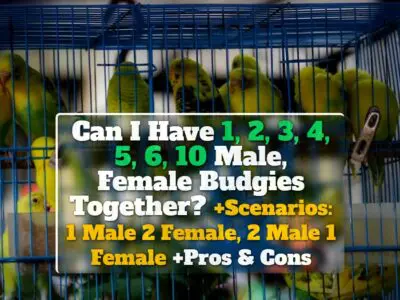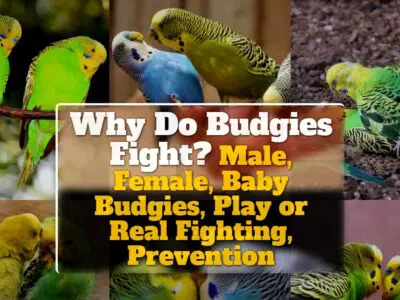Budgies, male and female budgies, typically reach sexual maturity around 3-4 months of age, but it is recommended to wait until they are 6-12 months old before allowing them to breed.
Baby budgies, under this age, are not physically mature enough to mate safely or successfully.
Curiosity about budgie mating behaviors sparked my journey into the world of bird-watching and breeding.
This led me to compile this guide to budgie matings, which I believe will prove valuable to bird enthusiasts, breeders, and budgie owners alike.
I drew on personal experiences, research, and observations to craft content that will help demystify the nuances of budgie mating.
What Age Do Baby Male Budgies First Mate?
It’s fascinating to watch how baby male budgies transition from their juvenile phase to adulthood, showing signs of maturity and a readiness to mate.
Male budgies typically reach sexual maturity around the age of 3 to 4 months.
Now, bear in mind, these are average numbers, and it might vary for some birds.
For instance, some male budgies might start showing signs of sexual maturity a bit earlier or later.
Factors like diet, environment, and genetics can play a crucial role in this process.
Once a male budgie reaches sexual maturity, he begins to exhibit certain behaviors that signal he’s ready to mate.
You’ll notice them singing more often, dancing around their cages, and feeding the females in an attempt to woo them.
It’s the start of an intriguing courtship that eventually leads to mating.
What Age Do Baby Female Budgies First Mate?
On the other hand, baby female budgies, also known as hens, usually mature a little later than their male counterparts.
The age of sexual maturity for female budgies typically falls around 4 to 6 months.
Just like male budgies, this timeline might differ based on the individual bird’s diet, environment, and genetic factors.
Once mature, female budgies will exhibit signs of readiness to mate.
These include becoming more receptive to the males’ advances, engaging in mutual preening, and displaying nesting behaviors.
At What Age Do Male Budgies Have Second And Subsequent Matings?
Budgerigars are an interesting species with a rather continuous breeding pattern.
Once a male budgie starts to mate, he can continue to do so for several years.
After a successful mating and the chicks have fledged, the male budgie is ready to start the process over again.
This could occur within a few weeks or months, depending on the budgie’s environment and health status.
It’s worth noting that male budgies can mate multiple times within a breeding season, which often aligns with the warmer months of the year.
However, it’s essential to provide them with ample rest between clutches.
Without this downtime, the male budgie may become stressed, which can lead to a decline in his overall health and well-being.
At What Age Do Female Budgies Have Second And Subsequent Matings?
Much like the males, female budgies are capable of having multiple clutches in their lifetime.
After the first successful mating and once the chicks have left the nest, a female budgie may go into breeding condition again.
The age at which this happens can vary significantly, depending on the bird’s health, her environment, and the availability of a suitable mate.
However, while a female budgie can technically breed multiple times a year, it’s crucial to give her body a chance to rest and recover between clutches.
Constant breeding and egg-laying can take a serious toll on a female budgie’s health.
In some cases, it can even lead to complications such as egg-binding or calcium deficiency.
How Can You Tell When A Budgie Is Mature And Ready To Mate?
Recognizing when a budgie is mature and ready to mate can be crucial for breeders and pet owners alike.
A combination of physical changes and behavioral cues usually signal that a budgie has reached sexual maturity.
Some of these signs include a change in plumage, the color and texture of the cere (the fleshy, wax-like area above their beak where the nostrils are located), and the smoothness of the beak.
In addition, a budgie’s behavior can also indicate its readiness to breed.
This includes increased vocalization, courtship behaviors, and in females, nesting behavior.
Vibrant Plumage (Feathers)
The feathers of a budgie can tell you a lot about their age and maturity.
Young budgies, both males and females, generally have a fluffy appearance with soft, downy feathers.
As they mature, their plumage becomes more vibrant and sleek.
Adult male budgies typically have bright, bold colors, while females may be a bit more subdued but still quite vibrant compared to their juvenile phase.
One of the telltale signs of maturity in budgies is the loss of their baby bars, the stripes that run down the forehead to the cere.
Adult budgies lose these bars, and their foreheads become one solid color.
Cere
The cere is another good indicator of a budgie’s maturity and readiness to mate.
In male budgies, the cere is usually a bright, solid blue in mature, ready-to-mate birds.
In contrast, young or non-breeding males may have a more purplish or pinkish hue.
On the other hand, female budgies have a cere that changes color with their breeding condition.
Outside of breeding, the cere may be a pale blue or whitish color.
However, when a female budgie is ready to breed, her cere becomes a crusty brown color.
Smooth Beak
The beak of a budgie also undergoes changes as the bird matures.
Young budgies often have a relatively smooth beak.
However, as they age, the surface of the beak becomes rougher.
When a budgie is mature and ready to mate, their beak is typically solid and smooth.
The beak’s color can also provide clues about the budgie’s health, which indirectly affects their readiness for breeding.
A healthy budgie typically has a clean, shiny beak that is a uniform color.
Clear And Bright Eyes
The eyes of a budgie can also reveal much about their age and readiness for mating.
Young budgies, also known as chicks, typically have dark, fully black eyes.
As budgies mature, a white or greyish ring called an iris ring develops around the black pupil.
A budgie with a clear iris ring is generally considered mature.
In addition to the appearance of the iris ring, the overall brightness and clarity of the budgie’s eyes are good indicators of their health and vitality, both of which are important for breeding readiness.
Clear, bright eyes without any discharge, cloudiness, or signs of irritation usually indicate a healthy, mature bird that might be ready for mating.
Behavior (Singing, Courtship Dances, Regurgitating)
The behavior of budgies changes markedly as they reach sexual maturity.
Males tend to sing more frequently and with greater complexity.
This singing is a form of courtship and is designed to attract females.
Courtship dances are another common behavior seen in mature budgies.
Male budgies may hop around, fluff their feathers, bob their heads, or present food to females as part of these dances.
Another courtship behavior is regurgitating food for their mate.
While this may seem off-putting to us, in the world of budgies, this is a sign of affection and an indication that the bird is ready to mate.
Nesting Behavior (Shredding Paper, Carrying Nesting Material, Territoriality)
Budgies’ behavior undergoes a noticeable shift when they reach sexual maturity and are ready to mate.
One of the most observable changes is in their vocalizations.
Males, in particular, become more vocal.
Their songs become longer, more complex, and louder.
Singing serves as a form of attraction, aimed at gaining the attention of potential female mates.
Observing this change in vocalization can provide a clear sign of a male budgie’s readiness to mate.
In addition to vocal changes, courtship dances also become a common sight.
Males show off with fluffed feathers, extended wings, and elaborate movements, all to impress the females.
This exhibition of physical prowess and vitality indicates a male budgie’s readiness to mate.
Regurgitating food is another behavior that signifies a budgie’s preparedness for mating.
This behavior, particularly common in males, is a way of feeding the female during the courtship period, demonstrating a caring and nurturing instinct that is important for the upcoming nesting period.
Budgies – especially females – may display increased territorial behavior.
As they prepare for nesting, females may become more protective of their space.
This behavior ensures a safe environment for potential eggs and offspring, further indicating their readiness to mate.
Leg Band
For many bird species, including budgies, a leg band is often applied when they are chicks.
This small, usually metal ring contains information about the bird’s hatch date and origin.
It’s a reliable way to verify a budgie’s age.
While the leg band doesn’t directly tell you whether a budgie is ready to mate, knowing the bird’s age can help make an informed guess.
Budgies usually reach sexual maturity around 3-4 months of age, but it’s recommended to wait until they are 6-12 months old before allowing them to breed, as this allows them to reach full physical and social maturity.
Faqs
What Is The Ideal Age For Breeding Budgies For The First Time?
The ideal age for breeding budgies is when they reach 6-12 months old.
While they may reach sexual maturity around 3-4 months, waiting until they’re fully matured ensures better health and safety for both parents and offspring.
How Often Can Budgies Mate After The First Time?
Budgies can mate several times throughout their lifespan, which can be up to 10-15 years in captivity.
However, for the sake of the female’s health, it is recommended to limit breeding to once or twice a year.
Can Budgies Mate Too Young?
Yes, budgies can mate too young.
Although they reach sexual maturity at around 3-4 months old, mating at this age can lead to health risks as they are not yet fully mature.
It is advised to wait until they are at least 6-12 months old for breeding.
Are There Any Risks Associated With Budgies Mating At A Young Age?
Yes, there are risks.
Young budgies, especially females, are more prone to egg-binding, a condition where they cannot expel an egg.
This can be fatal if not treated immediately.
It’s safer to wait until they are at least 6-12 months old for breeding.



